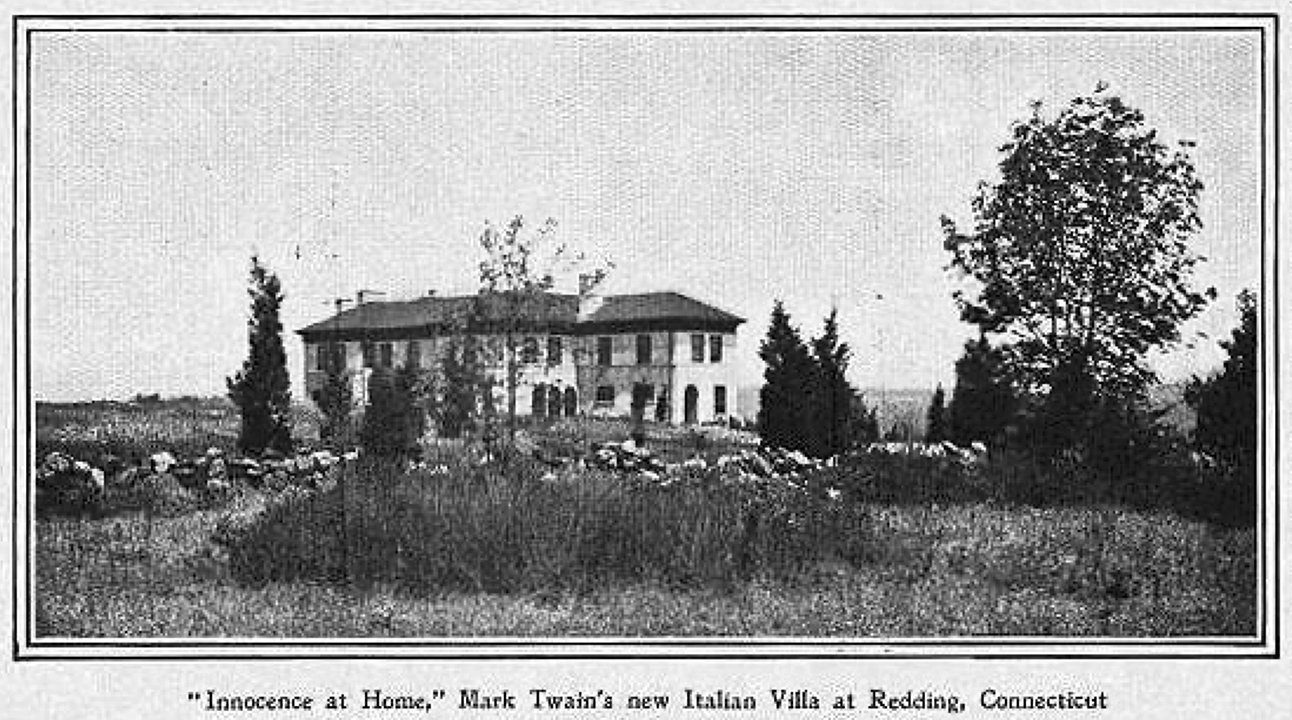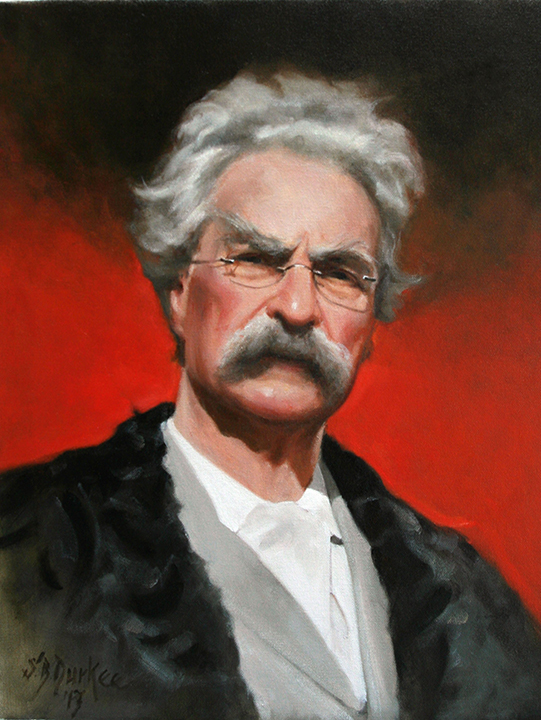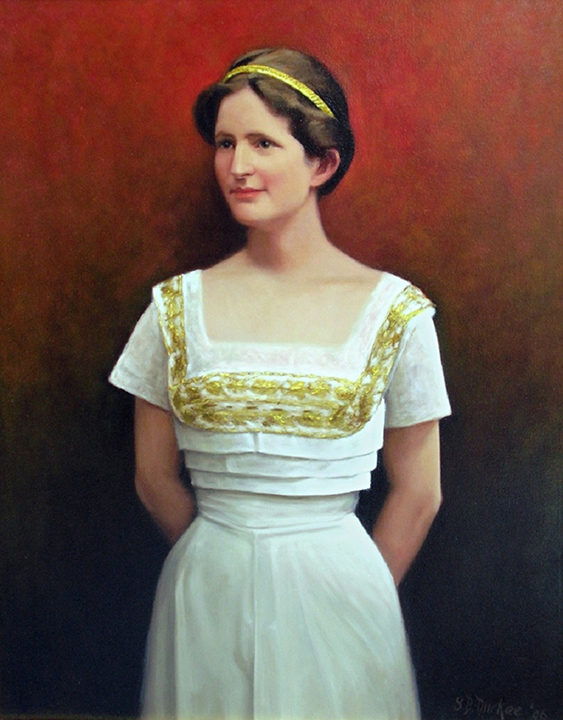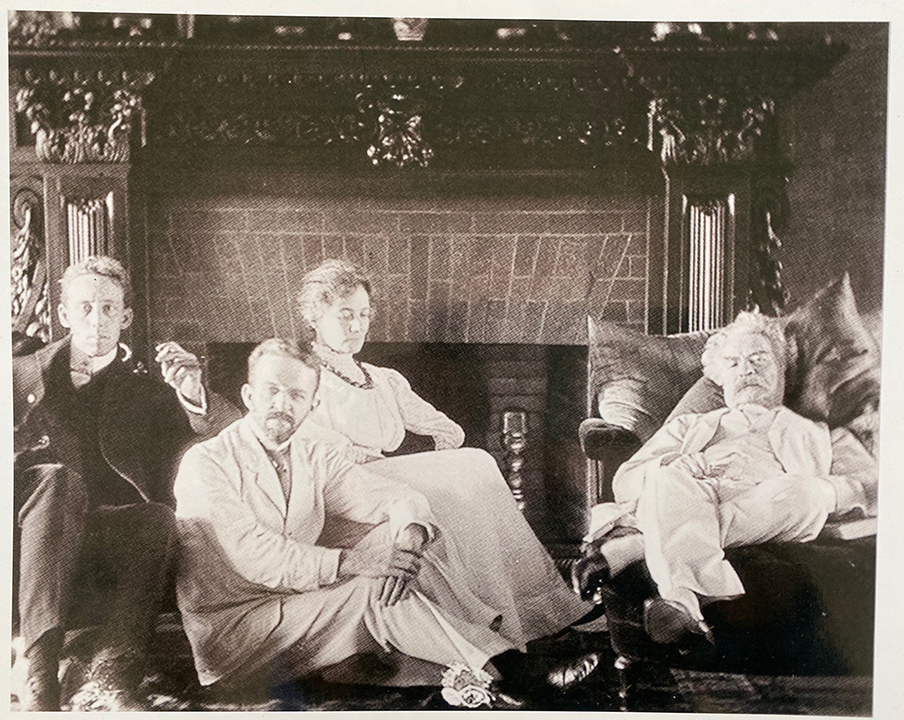
Mark Twain, the author and raconteur also known as Samuel Clemens, is an indelible part of the town of Redding. He spent the last two years of his life here, a time of both joy and heartbreak. He also left behind his legacy by founding the Mark Twain Library, which remains a cultural mainstay in Redding over a hundred years later.
Twain first heard about Redding from his biographer and friend Albert Bigelow Paine, who lived in town. Twain purchased over 240 acres in 1906 sight unseen, when he was in his seventies. He originally planned to hold the acres as an investment, but his daughter Clara and his secretary Isabel Lyon became enamored with the town and its quiet, rustic charm. He settled on an Italian villa style for his house — to honor his late wife Livy who died in Florence — and left the management of the construction to Lyon, who moved into the original house on the property.

 Twain arrived for his first visit on the train at the West Redding station to much fanfare and fireworks. Once installed in the house, Twain was asked if he was enjoying Stormfield: “Yes, it is the most out of the world and peaceful and tranquil and in every way satisfactory home I have had the experience of in my life. It is charmingly quiet here. The house stands alone, with nothing in sight but woodsy hills and rolling country.” Twain named his place “Innocence at Home,” taken from his book Captain Stormfield’s Visit to Heaven, but later changed it to “Stormfield.”
Twain arrived for his first visit on the train at the West Redding station to much fanfare and fireworks. Once installed in the house, Twain was asked if he was enjoying Stormfield: “Yes, it is the most out of the world and peaceful and tranquil and in every way satisfactory home I have had the experience of in my life. It is charmingly quiet here. The house stands alone, with nothing in sight but woodsy hills and rolling country.” Twain named his place “Innocence at Home,” taken from his book Captain Stormfield’s Visit to Heaven, but later changed it to “Stormfield.”
Life at stormfield
Twain kept busy when in Redding. He would hike the beautiful countryside with the Angelfish, his coterie of youth he assembled for lack of grandchildren. He spent time with his remaining family; Clara was a frequent visitor, and his youngest daughter Jean moved in after a long hospital stay for epilepsy treatment. Twain was thrilled to have Jean back and bought an adjacent estate for her, aptly named Jean’s Farm. She fell in love with Redding just like her father and had a menagerie of animals. She would ride on horseback for hours, getting their mail in town and enjoying the town’s fields and woodlands.
Many of Twain’s friends and colleagues visited him at Stormfield, including Helen Keller, Thomas Edison, and his illustrator and Boy Scouts founder Dan Beard, who lived just up the road. He and Albert Bigelow Paine enjoyed a close friendship full of conversation and idea-sharing. Twain enticed Paine into building a billiards room in his house to match Stormfield’s by telling him, “…when I want exercise I can walk down and play billiards with you, and when you want exercise you can walk up and play billiards with me.”
Throughout his time in Redding, Twain spoke of his desire to create the town’s first library, in part so he could contribute from his overflowing bookshelves. He started a temporary collection in a small former chapel that he could see from his home. “I am glad to help this library. We get our morals from books. I didn’t get mine from books, but I know that morals do come from books — theoretically, at least,” he said in a speech at the opening.

Twain’s library soon outgrew its original building, and Twain set his sights on constructing a more substantial place. He secured land from a local farmer, and in September 1909 hosted a fundraiser at Stormfield with a performance by Clara, a singer and musician. Admirers from all over traveled to Stormfield: “Some in 60 horse-powered motor cars, some in buggies and carriages, and a swarm of farmer young folk on foot from miles around — 525 all together,” Twain described in a letter to a friend. He also required any male visitor to Stormfield “to contribute a dollar or go away without his baggage” to put toward creating the library.
Twain experienced a time of domestic happiness in Redding, but on Christmas Eve 1909, tragedy struck when Jean likely suffered a seizure and was found the next morning, dead at the age of 29. This loss hastened Twain’s ill health, as he was already suffering from a weak heart.
While grieving, Twain wrote to his attorney about funds to secure the future of Redding’s library: “I want the money derived from the sale of [Jean’s Farm] to be used to erect a building for the Mark Twain Library at Redding, the building to be called the ‘Jean L. Clemens Memorial Building.’”
On April 21, 1910, Twain died at Stormfield. He was ushered out by Halley’s Comet, an appropriate end as it had greeted him at birth in 1835. The newly constructed Mark Twain Library opened in late 1910.
Today, over 100 acres of Twain’s Stormfield property are walking trails owned by the Town of Redding and maintained by the town’s Trail Tenders. Abutting Redding Land Trust parcels feature connecting trails as well, including Jean’s Trail named in honor of Jean Clemens. Twain’s original Stormfield house burned down in the early 1920s but was carefully rebuilt in the same style to honor the property’s history.
Over the years, the Mark Twain Library has grown from the small original building; additions were made in 1972 and 2000. Today the institution remains an essential part of the Redding community. “Mark Twain’s legacy has carried on at the library for over one hundred years, and his love and appreciation of intellect, independent thinking, and humor shines through in our work for the community every day,” said Library Director Erin Dummeyer.
The Mark Twain Library boasts a multitude of events for all ages, a dedicated staff, and, of course, carefully curated shelves. In addition to a partnership with the town, much of the library’s operations are funded by private donations from residents and admirers that appreciate its good works, continuing Mark Twain’s tradition of supporting a community of learning and engagement in Redding just minutes from where he enjoyed his last years.
Many thanks go to those who have captured Mark Twain’s history in Redding, including Susan Durkee, Brent Colley,
Bruce Nelson, and the Mark Twain Library. •